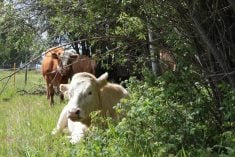With the increased frequency of storms comes more lightning strikes and more cattle being struck, and usually killed.
Even though there is little that can be done to prevent such losses, there are still several things to discuss. Questions to be answered include diagnosing the actual cause of death, determining whether there is insurance coverage and finding out if there is some type of disaster assistance available, depending on how many animals are involved.
I have written before on different types of electrocution and many times there is a solution to prevent future losses, but with lightning there is so much energy so quickly that survival is rare and there isn’t much that can be done.
Read Also

Cancer agency reclassifies another herbicide ‘probably carcinogenic’
The WHO’s cancer research agency has now put atrazine, a herbicide well known to corn growers, in the same potential-hazard category where the agency put glyphosate.
Anytime several animals appear to have died suddenly and there has been a severe storm, one has to be suspicious that lightning might be involved. Most deaths that I’ve seen occurred along fence lines or on high spots in the field.
Multiple deaths often occur where cattle have gathered for protection against the storm. Some have suggested increasing the number of ground rods used with an electric fence will reduce the risk of cattle being electrocuted, but the fact is there is so much electricity for such a short time that grounding only takes away some of it. I would imagine that if cattle were near the fence on the other side of the field from the strike, there may be only minor consequences. In my experience, damage such as blown-apart posts or large tree limbs burnt is evident in the immediate vicinity.
There are 2,000 to 3,000 human deaths annually in the U.S. due to lightning strikes. We are probably lucky there is a relatively low number of cattle death losses due to lightning in Canada, but there are no doubt some animals killed on pasture that are not found in time to confirm the diagnosis.
Symptoms
Signs of a lightning strike on the carcass include burn marks down the legs, because with four hooves on the ground, they are grounded so well. There is often a lot of subcutaneous hemorrhaging and there also are often large, prominent seromas (fluid-filled pockets) around the udders. Cattle killed by lightning decompose and bloat extremely quickly.
Other circumstances that can cause sudden death include blackleg, bloat, gunshots, water hemlock poisoning, blue-green algal poisoning, urea poisoning or anthrax. These causes need to be ruled in or out. There are a few other sudden deaths but if multiple deaths the diagnosis may become easier.
For producers coming across dead cattle, it is important to identify the cattle and inventory them in case they are insured under a farm policy that includes an “Act of God” coverage.
Because insurance is available, often disaster assistance programs will not cover these losses. I think they should provide compensation. Lightning-related death losses occur pretty infrequently and usually involve individual animals or pairs. Most producers can accept one or two animal death losses. But it’s the large losses of several animals at one time that’s disastrous, but to take insurance every year would be cost-prohibitive.
As several producers have told me though, it is the old Murphy’s Law of ranching. If they lose an animal it is usually the prized member of the herd or the young ones or a herd sire. Many of the individual death loss cases have involved a herd sire resting or standing high on a hill overlooking the herd. The good news is new herd sires are often insured for their first year and many times the storms happen after the breeding season is done.
In these sudden-death situations, if there is insurance or a chance of compensation make sure your veterinarian does at least an inventory and takes pictures of ear tags and at least attempts to autopsy and confirm pregnancy if possible. If females are killed, the loss includes not only the cow but the unborn fetus.
More natural disasters
With the more unpredictable weather patterns, there are more reports of other losses in the cattle industry. Causes can include drowning such as we saw in the B.C. floods, droughts, severe heat, wildfires, blizzards and hail damage.
All we can do is heed the warning of the weatherman and have some form of contingency plan to lessen the blow. Producers must always take into account their livestock as well as themselves, and seek refuge. Some of these weather issues can be widespread and cause big losses so disaster-type programs may be in the future of cattle production.
It is important to be prepared for a natural disaster as much as possible. At least know who to call and have some idea of services available, although hopefully they’ll never be needed.
If calling 911 in Albeta, ask for the “Emergency Livestock Handling Trailers.”These portable corral systems are available in about 20 locations spread around the province. They are for use in natural disasters and accidents such as rollovers. I think this emergency response was adopted in Alberta primarily because of the huge number of livestock transported on Alberta highways every day. These services are not specific to beef cattle but all farm animal species including chickens and pigs. Visit the Alberta Farm Animal Care Association (AFAC) website at www.afac.ab.ca to check out locations of the trailers.
Information and resources for dealing with a disaster are available from several sources including the Canadian Cattle Association as well as provincial beef organizations, vet clinics, auction markets, breed associations, and cattle transporters. Whether it is a question about transportation, feeding, or housing, in the event of natural disaster reach out and make use of the available resources.















